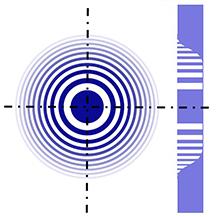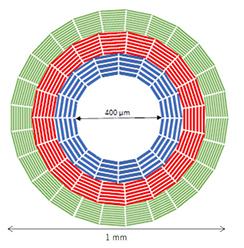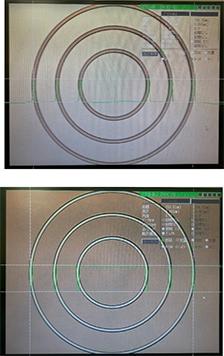For many years, NTT-AT has assisted synchrotron researchers with the development of X-ray optical components. Here, we would like to introduce some of our X-ray optical components that have not been published as products.
Case 1. Apodization X-ray Fresnel zone plate
 Fresnel zone plate with improved resolution with continuously varying absorber thickness
Fresnel zone plate with improved resolution with continuously varying absorber thickness

Ta pattern shape
X-ray microscopes that use synchrotron radiation as a light source generally use a Fresnel Zone Plate (FZP) as an imaging element.
NTT-AT has developed an "Apodization FZP" in which the thickness of the X-ray absorber changes continuously from the inside to the outside.
By using this FZP, it is possible to realize an X-ray microscope that achieves both high light collection efficiency and high resolution.
In 2017, Dr. Takeuchi's group at the Japan Synchrotron Radiation Research Center published research results using this device.
A Takeuchi et al, J. Phys.: Conf. Ser. 849 012055 (2017)
NTT-AT has developed an "Apodization FZP" in which the thickness of the X-ray absorber changes continuously from the inside to the outside.
By using this FZP, it is possible to realize an X-ray microscope that achieves both high light collection efficiency and high resolution.
In 2017, Dr. Takeuchi's group at the Japan Synchrotron Radiation Research Center published research results using this device.
A Takeuchi et al, J. Phys.: Conf. Ser. 849 012055 (2017)

Case 2. Sector condenser zone plate
 Contributes to uniform illumination of the observation target for X-ray imaging microscopes
Contributes to uniform illumination of the observation target for X-ray imaging microscopes

The sector condenser zone plate is an optical element developed for the illumination of X-ray imaging microscopes using synchrotron radiation.
This optical element has a structure in which equally spaced diffraction gratings are arranged radially, and by combining it with a center beam stop and an OSA (aperture for selecting the diffraction order of the zone plate) and rotating it, uniform illumination of the observation target can be obtained. can be realized.
NTT-AT 's sector condenser zone plate, in which three types of radially arranged transmission spacing diffraction grating patterns are arranged on a SiC membrane, was used for X-imaging microscopy experiments using SPring-8 BL37XU. Contributed to the realization of stable lighting.
In 2009, Dr. Takeuchi's group at the Japan Synchrotron Radiation Research Center published research results using this device.
A. Takeuchi et al, J. Phys.: Conf. Ser. 186 012020 (2009)
This optical element has a structure in which equally spaced diffraction gratings are arranged radially, and by combining it with a center beam stop and an OSA (aperture for selecting the diffraction order of the zone plate) and rotating it, uniform illumination of the observation target can be obtained. can be realized.
NTT-AT 's sector condenser zone plate, in which three types of radially arranged transmission spacing diffraction grating patterns are arranged on a SiC membrane, was used for X-imaging microscopy experiments using SPring-8 BL37XU. Contributed to the realization of stable lighting.
In 2009, Dr. Takeuchi's group at the Japan Synchrotron Radiation Research Center published research results using this device.
A. Takeuchi et al, J. Phys.: Conf. Ser. 186 012020 (2009)

Case 3. X-ray Zernike phase ring
 Transmissive element that realizes X-ray phase-contrast microscope
Transmissive element that realizes X-ray phase-contrast microscope

The method of converting the phase difference of a transparent substance into a light-dark contrast and detecting it is called phase-contrast observation, and has various applications. A ring element that gives a phase difference of λ/4 is used for this phase contrast observation.
The X-ray Zernike phase ring is an element that gives a λ/4 phase difference to X-rays in X-ray phase contrast observation.
Ta X-ray phase rings made by NTT-AT are mounted on X-ray imaging microscopes that use synchrotron radiation and are used to detect microscopic phase-contrast images.
In 2009, Dr. Takeuchi's group at the Japan Synchrotron Radiation Research Center published research results using this device.
A. Takeuchi et al, J. Phys.: Conf. Ser. 186 012020 (2009)
The X-ray Zernike phase ring is an element that gives a λ/4 phase difference to X-rays in X-ray phase contrast observation.
Ta X-ray phase rings made by NTT-AT are mounted on X-ray imaging microscopes that use synchrotron radiation and are used to detect microscopic phase-contrast images.
In 2009, Dr. Takeuchi's group at the Japan Synchrotron Radiation Research Center published research results using this device.
A. Takeuchi et al, J. Phys.: Conf. Ser. 186 012020 (2009)

inquiry
NTT-AT provides many X-ray optical components in addition to those introduced here, and supports customers' research and development in the fields of synchrotron radiation science, laser application, and industrial equipment. Please feel free to contact us for inquiries such as an estimate.Product Info
| X-ray Fresnel zone plate | X-ray chart <catalog product> |


 close up
close up